I am now on twitter
Still don’t see the point of it all but maybe I will fall in love with the tech.
http://twitter.com/henryolonga

Still don’t see the point of it all but maybe I will fall in love with the tech.
http://twitter.com/henryolonga

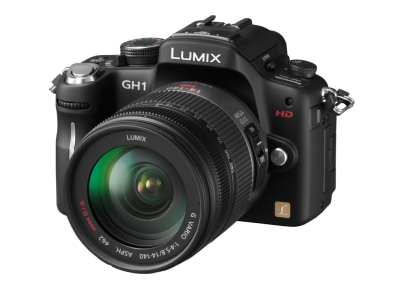
Well it was bound to happen at some time. Some clever hacker has proved that Panasonic could have done a better job with the programming of the codec for the GH1. Most people believe that the GH1 could be the pick of the video enabled DSLRs ( even though it isn’t technically a DSLR ). It has an articultaing LCD, interchangeable lens mounts that due to the short flange distance allow for the use of almost any lens ever made, large sensor at Micro 4 thirds that gives a filmic depth of field bla bla bla. Panasonic didn’t have the guts to unleash this baby as a winner and instead chose to cripple the codec. It is so bad that even my SONY HC3 HDV camcorder from FOUR years ago outperforms it!!!!What a shame because it is a simply stunning performer – except the codec………until now!!!!!!!!!! If you own a GH1 get over there and donate so we can free this baby – or at least get Panasonic to give us a decent codec.
Boy a few of us indies were so disappointed that the Matshushita crew didn’t give this baby a robust Canon like codec. Guess who is selling more cams in the indie filmm-aker arena. One hint – it’s not Pana. NAB saw everyone going crazy over DSLR rigs. That was the talk this year. Panasonic announced the GH1 camcorder equivalent called the AF100
At $ 6000 it is not a true indies dream.Okay not a poor indies dream….. It does have my attention because of HDMI and HD-SDI and it is confirmed that they will be live when recording.$5000 more for effectively what is a GH1 with less aliasing and live HDMI – I thought of going that route – until now………………………..My HFS10 with the Nanoflash and SGblade gives me an amazing picture as it is.I have a low light champ in the 5D MArk II and all that is left now is something I can stiuck on a Hague stabiliser for steadycam shots – ie. the GH1 with a good codec….WE MAY BE THERE SOON.
The hack has so far overcome a few issues – MJPEG is now able to record at 24p although frames get skipped. The bit rates have been able to get successfully upped for a few more precious mbps and some uses claim there is no mud to speak of now. It seems very promising.
The 30 minute limit has been overcome for EU PAL camera owners.You need to do the patching yourself and it will no doubt void any warranty so this is not for the faint of heart.
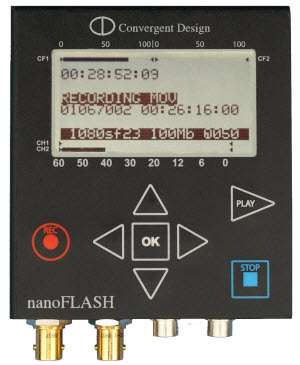
Some of you may be aware that for over a couple of years now I been on the forefront of HDMI capture and attempting to make it easier to do in the field. Well I held off for a few months but last month I eventually succumbed and bought the Nanoflash from convergent design. Capable of recording to compact flash cards the Nanoflash is a dream for anybody wanting to enter the realm of high quality HDMI capture. Of course the product can also capture to HD-SDI. I have made myself a DIY battery that can last a whole day if need be.
The output file is either i-frame or longop – ( long group of pictures ) and I will be recording to 180 mbps longop which surpasses anything the DIY project I did can achieve. The data rate at 8 bit technically has more information than the film scan rate of cineform at 10 bit. This makes it perfect for consumer camcorders like the HFS10.
Have a look at what it looks like in action. Go to Vimeo, login and download the original to get a feel for the detail captured.I was blown away.
HDMI capture,HFS10, SGBlade, Nanoflash, Nikkor 85 mm AI from Henry Olonga on Vimeo.
The long awaited update is here folks wooohooo
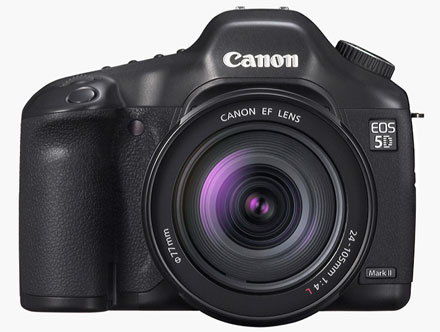
Canon adds 24 and 25fps HD Movie recording
to the EOS 5D Mark II with Firmware 2.0.3
London, 2nd March 2010 – Canon today pre-announces the release of a firmware update for the multiple award-winning EOS 5D Mark II. Originally announced in late 2009, the update adds 24* and 25 frames per second (fps) recording to the camera’s EOS MOVIE video function, and will be available as a free download from the middle of March.
Developed following feedback from photographers and cinematographers, Firmware 2.0.3 further enhances the EOS 5D Mark II’s excellent video performance. The addition of new frame rates expands the camera’s video potential, providing filmmakers with the ability to shoot 1080p Full HD footage at 24fps (actual 23.976fps) – the optimum frame rate for cinematic video. 25fps support at both 1920×1080 and 640×480 resolutions will allow users to film at the frame rate required for the PAL broadcast standard, while the new firmware will also change the 30fps option to the NTSC video standard of 29.97fps.
A new histogram display for shooting movies in manual exposure, shutter-priority (Tv) and aperture-priority (Av) have been added, and exposure modes will also be available in movie mode. Improved audio functionality will allow users to set sound record levels manually using a sound-level meter displayed on the LCD screen. The audio sampling frequency has also been increased from 44.1KHz to 48KHz, providing the optimum audio signal typically required for professional or broadcast material.
With its full frame CMOS sensor and compatibility with Canon’s wide range of premium lenses, the EOS 5D Mark II is already recognised for its outstanding HD video performance. Launched in September 2008, the camera immediately created a wide range of new possibilities for photographers and videographers, and the addition of new frame rates and manual audio levels extends those possibilities even further – allowing movie makers to shoot stunning movies to suit practically any creative purpose.
Extreme sports photographer Richard Walch was one of the first to be given the chance to use the newly updated EOS 5D Mark II to shoot the snowboarding movie “I Love My Friends”. Commenting on the EOS 5D Mark II’s video performance, Richard said: “The addition of the new frame rates opens up a whole new range of possibilities. If you’re a cinematographer, independent film maker or just enthusiastic about making your own movies, get out there and give it a try”.
“I Love My Friends” shot by Richard Walch on the EOS 5D Mark II with the new firmware includes a look behind the scenes video is available to view at http://www.canon-europe.com/eos5dmarkII.
The firmware will be available to download from mid-March from the Canon website http://www.canon.com/eos-d/
*Actual frame rate: 23.976fps
I did a few Cineform vs AVCHD comparisons a while back ( here and here ).I have also done an HDMI capture tutorial to help build a rig and highlight the benefits of bypassing in-camera compression to get a clean image from cheap camcorders.Now I have been asked again to do some kind of torture test.I have no time for that so I will just place some first generation files for all to see what the big fuss is all about.HDMI capture surpasses AVCHD in the areas of colour,sharpness and freedom from codec artifacts bla bla bla.Don’t believe – download my sample files below and try them – you will need the Cineform Codec which you can get here.
The proof is in the pudding so I have made available some first generation files for your perusal.Three of them are a comparison of the same scene shot simultaneously.One long AVCHD file and the two Cineform files – sorry – it was snowing here.The rest are well – hopefully a nice selection of different subjects that I hope will put this argument to bed.If you think AVCHD can look this good then sample these.As for me – I think the quality speaks for itself.These are large files so be patient when downloading.
Hope this helps some of you to ascertain the quality.I suggest that for the ones with cinemode (The flat/low contrast Canon in-camera setting) you take them into Cineform’s first light and play with them.Especially the horses in the field.Not the snow field….he he.You will be amazed at the leeway you have with a 10 bit file.It colour grades beautifully.Oh and yes – I know the HFS10 has aliasing and yes the start of each file has some wierd interlacing lines (because Cineform has to guess the cadence and it takes a second or two).A better camera would give better results………but come on – this is turning a relatively cheap consumer camera into an expensive one without forking out the thousands right………………………it’s still a consumer cam…..remember it’s only just on a grand now for an HFS10.
Soon and very soon Tara and I will be heading up to Scotland to do some shooting of that wonderful landscape.I will aslo be doing some shorts with our good friend Sarah Wrigglesworth in the coming days.The big news however is that I will be going to be hopefully making my first feature length film next year.Lets say it may involve a well known cricket club I am associated with.tsk tsk Still in two minds what to shoot on.
SR11,HFS100,GH1,5D orwith or without SGBlade and whether to do it to Cineform.Oh well – I would love the best but portability becomes an issue.Perhaps the cinedeck is the way forward.
Well at least audio is sorted out
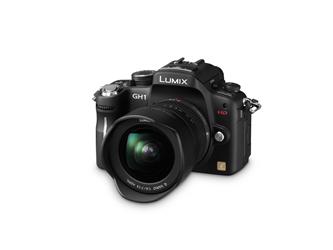
If this isn’t one of ther best cameras to come out of Panasonic in recent years then I don’t know what is.It takes gorgeous stills and this thing is made for video.No mirror to worry about,great sized sensor for increased control over depth of field but I am disappointed at the codec.It has been described as turning to mud on panning.So in a nutshell – keep it still and you get good results – move the baby and it isn’t pretty.At least for someone like me who has been capturing through the HDMI port of camncorders for years I can only see this as deliberate crippling.
Allow me to suggest that this is short sighted and Pana are shooting themselves in the foot.I know that Panasonic have a high end video line to protect … but would one rather sell 20 000 £20 000 high end cameras or 500 000 £1000 cameras?
Anyway that is not the biggest issue.Canon have kept their train moving forward with the 7D.Now buyers can have great abundant glass and three cameras (5D,7D,1D) that shoot amazing video to a great Codec.Nikon are breathing down everyone’s neck and RED are about to turn the market upside down at the end of October.As far as DSLR video goes Sony are also party pooping by basically not even showing up yet.But then again – with them your looking at perhaps £200 000 for the privilge of having an F35 that gives you interchangebale lenses on a 35 mm format camera.I reckon that when they join the party they can and will surpass everyone else.WHY get left behind when you can be leading the pack?
For Panasonic to rain on the VDSLR Parade (even though the GH1 is not a DSLR) they should set this puppy free.They can do this by allowing users to record the HDMI output live pre compressed to a Codec of their choice.This will see people flocking to buy this baby.I already own it and for stills it is amazing but it’s video has a lot more to offer.I don’t buy the sentiments that it cannot do this and record to the codec at the same time either.I am no engineer but my three year old HDV camcorder can do this without breaking into a sweat and Pana brag about how powerful the engine is.Okay then turn off all the power hungry processes and just pipe the data through to the HDMI pot instead of to the encoder.SIMPLES.
One of the greatest assetts of this puppy is its ergonomics.It is compact,has an articulating LCD screen and has interchangable lenses on a large sensor.What more would an indie film-maker want.This thing can go on a steadicam merlin and with that you are set to make blockbusters.Oh you also need a good story,good actors,a good DOP,sound tech,great director,good lighting ……….you get the picture anyway.
I have read of many people on professional video forums who returned the GH1 in frustration because of the codecs limitations.I am not saying it is rubbish – just not what it should be.If Pana sit on the fence on this one they will continue to see many leave after the better offerings from the market and this need not be the case.RED have shown the way to do business.Keep your loyal customers happy by improving their existing product with firmware upgrades and then give them a huge incentive to go for your next big product.Canon have realised this too and in this economy ( and Pana have already been affected by it – they laid off a few people early in the year) people just aren’t going to keep buying the next thing you put out with a small incremental upgrade.
Firmware upgrade Pana….Uncompressed HDMI????Pretty please.
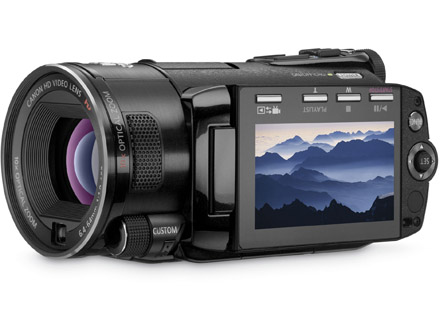
I have amended my HDMI capture tutorial to include developments in the industry in the last few months.Check it out.
Now for those of you who have an interest in capturing to a high quality recorder from the HDMI on the HFS10 – you may have had a little trouble getting the HFS10 to talk to your capture card.If you do not own one you won’t know how annoying it is.Well after months of searching I found a simple solution that costs about £80.
You have two options.
One is to get the component HD cable from canon for your HFS10/100.It is called CTC-100.You will need separate audio recording through your analog connections on the Intensity pro which I found to be a pain. This has no EDID issues as it is all analog.
You see the camcorder would go crazy if I plugged it into anything other than an LCD.It is to do with the EDID of the Canon.I got a little box from a company here in the UK that allows you to set the EDID manually .
It is fairly small and uses 5v power.I did a DIY hack to get power from a a USB port from my portable power supplie’s USB port.You know the external laptop battery extenders – you can see it in my video 17 tutorial on Vimeo.Takes the HSF10’s HDMI signal negotiates – passes it on to the intensity – works a treat.
Look for something similiar where you live.
http://www.cypeurope.com/stockists.html
This is a short Cineform first light test.
Cineform first light grading test from Henry Olonga on Vimeo.
– workflow is coming together.Shoot,grade in Cineform’s first light,Edit,Render,upload.Simple.

This camera has been anticipated with bated breath for a while and it promises to produce fantastic images.
Of note is the video which makes a great case for the convergence of stills and moving pictures.
Where oh art thou oh fabled RED scarlet?The masses await your arrival.
It’s not perfect and from my initial observations of original footage around the interweb – there are still aliasing artifacts as in the 5D,no uncompressed HDMI the rolling shutter is better controlled but still there somewhat and one will need to use profiles to get it looking less like video.However in the right hands this tool will produce some amazing story telling.I personally prefer the Depth of field adaptor look from my SGBlade and HFS10 recorded to my DIY cineform recorder but it has it’s limitations – mainly poor low light performance.I suppose that is where this camera could fill the gap or indeed Canon could release a firmware update for my EOS 5D mark II.That would do nicely…..
Now my rant for the day has to do with Panasonic.They could have made the GH1 so much better.They have a new codec coming out that does 12 bit 4:4:4 called AVC Ultra for their professional models but they gave the camera by most judgements an inferior codec.Whether this is by design or not I am not sure but they have given ground to Canon by not giving a superoir codec on the GH1 – and it is in their reach.Please Pana – get a fantastic codec on the GH1 and I will buy one.Especially the AVC-ultra.It is the perfect size to fit in my portable Cineform recorder….or even better to recover sales – give it uncompressed HDMI – this is the future and Nikon may have an offering soon.Please, please pretty please?